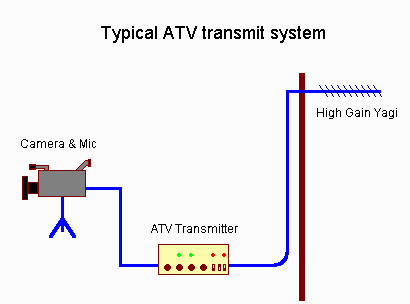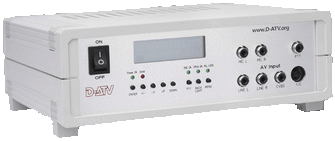Transmitting ATV Pictures
Overview
The basic components of an ATV transmitter system are: A camera or camcorder, a suitable ATV transmitter and a high gain antenna, typically a Yagi, with horizontal polarization being used on all frequencies in the Melbourne area.

Cameras
Just about any camera that produces video that your transmitter will accept will work as your video source. If you don't have a camera then the video out of a computer or recording device can be used. The most common video camera is of the camcorder variety as a majority of people have one of these already. There are older cameras that can be acquired very cheaply but they usually need more light and are physically larger than the modern equivalent. If cost is a factor then the older cameras work well and can be picked up at places like cash converters for next to nothing. The audio out of the camera microphone is fine for the audio to your transmitter but most stations are using external microphone's.
Frequency Selection
At present, there are 3 video inputs to the VK3RTV ATV repeater: 1244MHz, 1256MHz, and 1287MHz which are all DVB-S2 or DVB-S inputs. The 1287 MHz antenna is pointed NW, the 1255 MHz antenna is pointed NE, and the 1255 MHz antenna is pointed SE. See the VK3RTV & Melbourne ATV frequency plan for more specifics.

From most areas of Melbourne, stations are having great success getting full quieting digital signals into the repeater with modest yagi's ( 1m - 2m boom ) or small gridpac dishes, good low loss feed lines, and 1 (some down to 100mW) to 10W of power.
Transmitters

On 23cm, all that seems to be needed from most areas of Melbourne with line of site to Mount View is 1 - 20 Watts of power and an antenna of 10dB gain or more. The antenna should be horizontally polarized and should be mounted such that it has as line of site view of VK3RTV on Mount View. It should be fed with low loss coax such as Times Microwave LMR400 or similar.
Transmitters for sending a signal to VK3RTV can be either DVB-S, DVB-S2, or DVB-T.
Currently HIDES sell a DVB-T transmitter that works.
You may be able to aquire a SR Sytems transmitter that can be DVB-S, DVB-S2 or occasionally DVB-T. The SR Sytems devices are no longer in production but can occasionally be found second hand.
The BATC produce a DVB transmitter called a Portsdown that can be built up from a Raspberry Pi and a Adalm pluto or Lime SDR. Check out the BATC website for details.
Various exciter/ modulators for DVB can be found from different manufacturers but that can at times be very hit and miss as to wether it works with VK3RTV.
It appears currently, the easiest way is to use an Adalm Pluto with firmware available via a link on the Equipment & Software page on the site. The Pluto is fed via OBS or VMIX running on a computer with the output fed to an amplifier and antenna of your choice. Some items can be bought as kits or others as boards that are wired together.
For ideas on where to get transmitters, kits or parts see ATV equipment sources.
All of the transmitters currenly available will require an amplifier (and maybe a preamp) to get the output up to an acceptable level.
Antennas

On 23cm, all that seems to be needed from most areas of Melbourne with line of site to Mount View is 1 - 10 Watts of power and an antenna of 10dB gain or more. The antenna should be horizontally polarized and should be mounted such that it has as line of site view of VK3RTV on Mount View. It should be fed with low loss coax such as Times Microwave LMR400 or similar.
Yagi's (mostly loop yagi's) and gridpac dish's are the most antennas used for VK3RTV. Loop yagi's are normally home made but can be purchased from some of the antenna manufacturers. A spread sheet describing the construction of a loop yagi can be found on the Equipment and Software Page of this website. Gridpacs for 23cm can be purchased from various sources including the various chinese internet vendors.
